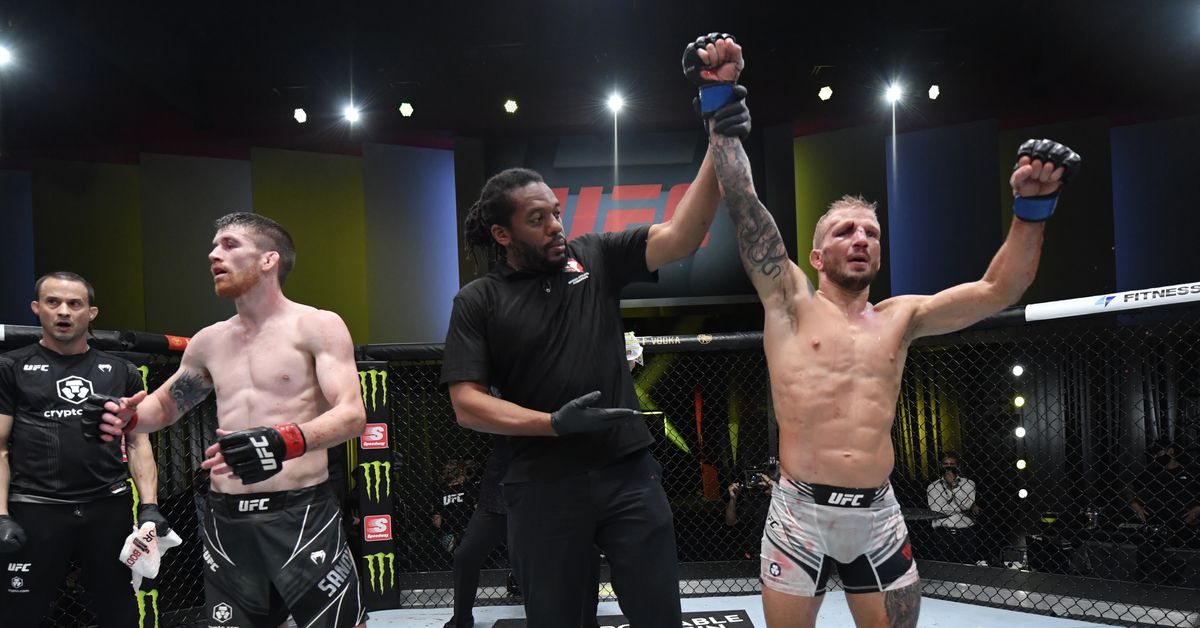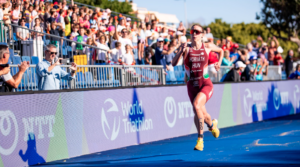https://www.bloodyelbow.com/2021/7/28/22597274/ufc-commentary-scoring-judging-not-good-heres-fix-cormier-cruz-fitzgerald-rogan
There were problems with the scoring at UFC Vegas 32, especially in the main event bout between Cory Sandhagen and T.J. Dillashaw. With the judges taking most of the heat, the UFC’s commentary team of Daniel Cormier, Dominick Cruz and Brendan Fitzgerald escaped criticism. They shouldn’t have.
The commentary spoke little about the scoring of the fight between Sandhagen and Dillashaw during the first 15 minutes of the contest. The talk of the judging picked up in the final 10 minutes and it did not enhance the broadcast or the understanding of how MMA fights are to be scored.
I look at some of the commentary below.
Cormier (early in Rd. 4): “I feel confidently that it’s two rounds for Dillashaw. Those leg kicks are paying dividends. The outside leg kicks are constantly landing. He’s touching up Cory Sandhagen with those shots.”
Dillashaw’s leg kicks were landing, but they were not paying dividends according to the scoring criteria. The kicks did not, as the scoring criteria shows, “produce immediate or cumulative impact with the potential to contribute to the end of the match…”
Dillashaw’s kicks did not stop Sandhagen from moving forward. They did not force him to switch stances. The kicks did not wobble Sandhagen at any point. Yes, they landed, but they paled in effectiveness when compared to Sandhagen’s punches.
The following exchange took place later in the fourth round:
Cruz: “T.J. does this every round, like I was saying. Every round he’s gotten behind him and gotten to this position. How are the judges seeing that? We don’t know right now according to the last couple — judging.”
Cormier: I have no idea how to judge a fight in this climate. I don’t know what’s happening. I really don’t know what’s happening.
Cruz: Are they going to score the takedowns? I think it’s going to come down to this fifth round.
Cormier: But they don’t count takedowns whenever you take the back, right? How many times has T.J. been on his back…
Cormier: Like this (Dillashaw puts Sandhagen against the cage.) They won’t count this as a takedown. But he’s in an advantage position, right? This may be counted as a failed takedown attempt because he hit the legs first. The reality is that every time somebody hits the leg, it’s not intended for you to take him all the way to the ground.
Cruz: This is just octagon control is how I see it, not necessarily a takedown. He’s not trying a takedown until he drops to the legs. He is just holding on to this man here.
Fitzgerald: But these exchanges loom large because they are so close in the striking numbers.
Yes, Dillashaw got behind Sandhagen and held him against the cage. But that is all he did. He did not produce any offense from that position other than some knees to the back of Sandhagen’s thighs. With no offense being produced, the judges should not have considered the control Dillashaw had.
Fighting area control is a scoring criteria, but as the rules say, “Fighting Area Control shall only to be assessed if Effective Striking/Grappling and Effective Aggressiveness is 100% equal for both competitors. This will be assessed very rarely.”
With Sandhagen having the better striking in this round, fighting area control would not have been scored at all.
The takedowns that Dillashaw scored would also not have had any bearing on the scoring because, as the scoring rules say, “It shall be noted that a successful takedown is not merely a changing of position, but the establishment of an attack from the use of the takedown.”
Dillashaw did not establish any attack after a takedown. He didn’t look to pass guard, work toward a submission or land ground strikes. With that, the takedowns were meaningless under the scoring criteria.
Strike counts are not any sign of striking effectiveness. Far too often we hear about the number of strikes being landed when the number of strikes landed is not what judges look at. Judges look at the effectiveness of those strikes.
What really bothered me was how the commentary crew tried to guess what the judges were looking at. That confuses the viewers at home and sends an incorrect message. To guess what the judges are going to score rather than sticking to the criteria as it is written encourages everyone viewing to score in any way they think is correct. It is necessary for the commentary team to stick to the scoring criteria as it is written and point out as often as possible the exact wording of the criteria.
Cormier (Rd. 5): I wonder how much stake the judges are putting into this position right here. I wonder if they’re giving Dillashaw credit for getting here over and over again against Sandhagen.
Again, the judges should have point zero stake in the position against the cage because that position produced no offense.
After Saturday I hope the UFC discourages the commentary team from speaking about scoring and judging. While the commentators might know the criteria as it is written — and I have my suspicions they do not — they were winging it on Saturday. That has to stop.
If the UFC wants to have someone speak about the scoring in the fights, it should bring someone into the team that has taken the judging course or at least someone who has an excellent understanding of the scoring criteria. An example of this in boxing was the late Harold Lederman, who served in that role for many years.
If the UFC adds a position like that, the commentary team can go to that person and have them offer their informed opinion on the scoring and what they see according to the criteria and not according to what they think the judges are doing.
Scoring in MMA is a problem. Commentary on scoring in MMA is often just as much of a problem. The commentary is the easier fix, but it needs to be fixed as soon as possible.


















